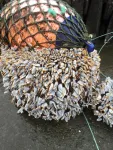(Press-News.org)
With the rise in global demand for staple crop products projected to substantially increase by 2050 due to population growth, rising per capita income, and the growing use of biofuels, it is necessary to adopt sustainable agricultural intensification practices in existing croplands to meet this demand. However, estimation processes currently employed in the global South remain inadequate. Traditional methods like self-reporting and crop cutting have their limitations, and remote sensing technologies are not fully utilized in this context.
However, recent advancements in artificial intelligence and machine learning, particularly deep learning with convolutional neural networks (CNNs), offer promising solutions here. To explore the scope of this new technology, researchers from Japan conducted a study focusing on rice. They used ground-based digital images taken at harvesting stage of the crop, combined with CNNs, to estimate rice yield. Their study appeared online on 29 June 2023 and was published on 28 July 2023 in Volume 5 of Plant Phenomics.
“We started by conducting an extensive field campaign. We gathered rice canopy images and rough grain yield data from 20 locations in seven countries in order to create a comprehensive multinational database,” says Dr. Yu Tanaka, Associate Professor at the Graduate School of Environmental, Life, Natural Science and Technology, Okayama University, who led the study.
The images were captured using digital cameras which could gather the required data from a distance of 0.8–0.9 meters, vertically downwards from the rice canopy. With Dr. Kazuki Saito of the International Rice Research Institute (formerly Africa Rice Center) and other collaborators, the team successfully created a database of 4,820 yield data of harvesting plots and 22,067 images, encompassing various rice cultivars, production systems, and crop management practices.
Next, a CNN model was developed to estimate the grain yield for each of the collected images. The team used a visual-occlusion method to visualize the additive effect of different regions in the rice canopy images. It involved masking specific parts of the images and observing how the model's yield estimation changed in response to the masked regions. The insights gained from this method allowed the researchers to understand how the CNN model interpreted various features in the rice canopy images, influencing its accuracy and its ability to distinguish between yield-contributing components and non-contributing elements in the canopy.
The model performed well, explaining around 68%–69% of yield variation in the validation and test datasets. Study results highlighted the importance of panicles—loose-branching clusters of flowers—in yield estimation through occlusion-based visualization. The model could predict yield accurately during the ripening stage, recognizing mature panicles, and also detect cultivar and water management differences in yield in the prediction dataset. Its accuracy, however, decreased as image resolution decreased.
Nevertheless, the model proved robust, showing good accuracy at different shooting angles and times of day. “Overall, the developed CNN model demonstrated promising capabilities in estimating rough grain yield from rice canopy images across diverse environments and cultivars. Another appealing aspect is that it is highly cost effective and does not require labor-intensive crop cuts or complex remote-sensing technologies,” says Dr. Tanaka enthusiastically.
The study emphasizes the potential of CNN-based models for monitoring rice productivity at regional scales. However, the model's accuracy may vary under different conditions, and further research should focus on adapting the model to low-yielding and rainy environments. The AI-based method has also been made available to farmers and researchers through a simple smartphone application, thus greatly improving accessibility of the technology and its real-life applications. The name of this application is ‘HOJO’, and it is already available on iOS and Android. The researchers hope that their work will lead to better management of rice fields and assist accelerated breeding programs, contributing positively to global food production and sustainability initiatives.
About Okayama University, Japan
As one of the leading universities in Japan, Okayama University aims to create and establish a new paradigm for the sustainable development of the world. Okayama University offers a wide range of academic fields, which become the basis of the integrated graduate schools. This not only allows us to conduct the most advanced and up-to-date research, but also provides an enriching educational experience.
Website: https://www.okayama-u.ac.jp/index_e.html
About Associate Professor Yu Tanaka from Okayama University, Japan
Dr. Yu Tanaka is an Associate Professor at the Graduate School of Environmental, Life, Natural Science and Technology at Okayama University. His research interests are environmental, agricultural, crop production science, and the use of artificial intelligence- based research methods in these disciplines. He has extensively worked on production, yield estimation, genetic variation studies involving the rice crop.
END
The NIH/National Institute on Aging has awarded a R01 $3 million grant to study the impact of a probiotic/prebiotic (synbiotic) medical food developed by Solarea Bio on maintaining bone health of older women.
The study will support an 18-month clinical trial of a synbiotic medical food in 220 older women to test whether it maintains lumbar spine bone mineral density (BMD) with aging.
Grant recipients are Hebrew SeniorLife, USDA HNRCA at Tufts University, Maine Medical Center Research Institute, and Solarea Bio.
“There is an unmet need for safe and effective dietary interventions for the ...
TAMPA, Fla. (Aug. 23, 2023) – A University of South Florida geoscientist led an international team of researchers to create a new method that can reconstruct the drift path and origin of debris from flight MH370, an aircraft that went missing over the Indian Ocean in 2014 with 239 passengers.
Associate Professor Gregory Herbert was inspired the moment he saw photographs of the plane debris that washed ashore Reunion Island off the coast of Africa a year after the crash.
“The flaperon ...
DALLAS, August 23, 2023 — A 2023 survey from the American Heart Association conducted by The Harris Poll, found that a majority (70%) of heart attack and stroke survivors are unaware that LDL cholesterol is commonly referred to as 'bad cholesterol.' This matters because LDL cholesterol (low-density lipoprotein cholesterol) significantly contributes to the development of cardiovascular disease, increasing the risk of heart attacks and strokes. According to the Centers for Disease Control and Prevention, ...
Worldwide, the practice of preparing agricultural fields by burning crop residue contributes large quantities of gaseous pollutants and aerosol particles to the atmosphere and is a known cardiorespiratory health hazard. It has been shown that combustion byproducts in smoke cross the blood-brain barrier causing brain inflammation, and repeated inhalation of smoke can contribute to cognitive decline and dementia among older adults.
Federal efforts to monitor air quality have been focused on population-dense urban communities. As such, impacts of smoke exposure from agricultural fires ...
Figuring out how hundreds of different kinds of brain cells develop from their unique expression of thousands of genes promises to not only advance understanding of how the brain works in health, but also what goes wrong in disease. A new MIT study that precisely probes this “molecular logic” in two neuron types of the Drosophila fruit fly, shows that even similar cells push and pull many levers to develop distinct functions.
In the study in Neuron, a team of neurobiologists at The Picower Institute for Learning and ...
INDIANAPOLIS – A new study from researchers at Regenstrief Institute and Indiana University School of Dentistry reports on linking electronic health records and electronic dental records to provide better care and outcomes for individuals with Sjögren's disease, an autoimmune disorder that can affect the entire body, including teeth. Their work may have implications for other systemic autoimmune diseases, including lupus and possibly rheumatoid arthritis.
Sjögren’s is a chronic autoimmune connective tissue disorder affecting four million Americans ...
Researchers from Lehigh University, University of Hong Kong, and Wuhan University published a new Journal of Marketing article that examines in-feed advertising’s performance across subscription versus AI recommended news feeds.
The study, forthcoming in the Journal of Marketing, is titled “Tales of Two Channels: Digital Advertising Performance Between AI Recommendation and User Subscription Channels” and is authored by Beibei Dong, Mengzhou Zhuang, Eric (Er) Fang, and Minxue Huang.
How ...
PLYMOUTH MEETING, PA [August 23, 2023] — Today the National Comprehensive Cancer Network® (NCCN®)—a not-for-profit alliance of leading academic cancer centers—announced Crystal S. Denlinger, MD, FACP, as incoming Chief Executive Officer (CEO). Dr. Denlinger—who is currently NCCN’s Senior Vice President, Chief Scientific Officer—is being promoted to lead the global guidelines organization following a national search to replace the retiring longtime CEO, Robert W. Carlson, MD.
Dr. Denlinger has a long history of global cancer care leadership with NCCN and beyond. She was named an ...
NEW YORK, August 23, 2023 — Physicist Matthew Sfeir is among 21 innovative mid-career scientists who will each receive $1.25 million from the Gordon and Betty Moore Foundation to pursue experimental physics research with the promise of significantly transforming understanding of physics and facilitating next-generation technological breakthroughs.
The five-year Experimental Physics Investigator Award will allow Sfeir—a Photonics Initiative professor with the Advanced Science Research Center at the CUNY Graduate Center (CUNY ASRC) ...
New Yorkers can apparently breathe a sigh of relief, at least for now. Their exposure to the smoke in June 2023 from Canadian wildfires led to only a slightly higher bump in visits to New York City hospital emergency departments for breathing problems or asthma attacks than what is seen on days when pollen counts are high. However, authors of a new study say other possible health effects, such as possible heart attacks and stroke, still need to be investigated.
For the study, researchers at NYU Grossman School of Medicine analyzed daily levels of air pollution, as measured ...







